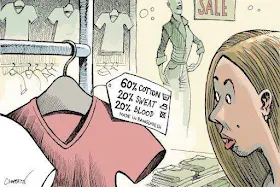 |
| More like 50% cotton, 20% blood, 20% sweat, and 10% tears. |
I rented a home with a walk in closet while I was a student at university. I didn't (and still don't) have much in the way of a need for a closet so large, so I did the studious thing and converted it to an office.
Even now I keep my small wardrobe (and Linda's) hanging in a tiny closet and stuffed in a few boxes on the shelves contained within it. We don't have any other clothing related furniture - no dresser, no stand alone wardrobe, no plastic bins stacked to the ceiling with unworn clothes destined for the second hand shop.
Minimizing our wardrobe has saved us a lot of money, and has made clothing decisions in the morning much more simple.
By reducing our wardrobe, and by making the clothes we do have last, we have reduced the amount of harm and suffering done on our behalf in order to cover our naked bodies.
And as the world has learned, there is a lot of harm and suffering manufactured alongside the stacks of clothing that come out of factories the likes of which we have not seen in north America since the 1900s.
Clothing Industry Issues
- The global textiles market is huge, worth more than $400 billion per year.
- In recent years, production has been growing by up to 25 percent.
- The Asian region has become the highest contributor of textiles in the world.
- Workers have long suffered in the ready made clothing industry, like the Triangle Shirt Factory fire in 1911 in New York City where 145 workers, mostly young girls, were burned to death because their tenement factory lacked adequate fire escapes.
- The textile industry has always been competitive, but from 2008 to 2010, the rapidly globalizing industry struggled to return profits - rising labor costs and the financial crisis put downward pressure on money-making.
- Fierce competition in low-wage countries drove down what employers were willing to pay workers.
- Business owners in developing countries cut corners in building safety and work conditions, abetted by lax enforcement of rules and desperate workers forced to accept harsh conditions.
- Workers often labour long hours for very low pay resulting in the worst case scenario - the infamous sweat shop populated by children.
- Chemical processing of fibers and textiles is known to have a far reaching impact on the environment, often poisoning local water sources.
- Some workers are exposed to harsh chemicals directly in manufacturing, resulting in serious health issues.
- 2.4% of the world's arable land is planted with cotton yet it accounts for 24% of the world's insecticide market and 11% of global pesticides sales, making it the most poison-intensive crop on the planet.
Future of the Industry
- Old methods with chemical-heavy production practices are no longer in line with environmental ideals, and the industry is being pushed toward greener methods.
- In the past several years the sales of eco-friendly textiles have seen double-digit growth.
- From 2006 to 2010, the sales of organic textiles in the United States alone has grown more than 600 percent.
- Increasingly aware customers expect the manufacturers of their clothing to place more emphasis on natural fibers, eco-friendly methods of manufacture, and ethical treatment of workers.
- source
We (couple) have a stand alone wardrobe with 4 small doors. Each of us gets 2 doors. We keep all our clothing and heavy blankets there (2 blankets - one for us and one for visits). We also keep our toiletries there. We really don´t need or want to have more stuff so whenever people ask me what to get me as a gift i will ask for an experience-gift or for toiletires, because they get used up and we can save the money we would use to buy those products. We don´t have nighstands but we do have one dresser that we use to keep our shoes organized. One of it´s drawer is empty, though.
ReplyDeleteI have very fez clothing itens. i try to get really good products so they will last longer and fit nicelly. Most of my clothes come from trift shops; it´s cheaper, it´s easy to find good stuff and i feel it´s a way to lower environmental impact.
Hugs from Brazil!
Marina, You have a rational approach to clothing. There is something about empty drawers that appeals to me. They are rare in the average home, perhaps as rare as a garage in which you can actually park a car.
DeleteWe have been thinking about you a lot with recent events in your country. The power of the people is on display for your politicians and the world to see. Thank you - we are totally inspired by the active participation of millions of Brazilians in demanding change. That is the way to get it done. I hope the action results in real change.
Change is sorely needed in Canada, too, and our countries are similar in that the environment is threatened by unchecked resource development. Then you add government mismanagement, growing inequality, and an erosion of public services like health care and education, and I am surprised Canadians aren't out in the streets as well.
I do believe, though, that our time is coming. In the meantime we have a lot to learn from you and your people. Thanks for checking in with us!
Take care,
Hugs back at you from Canada.